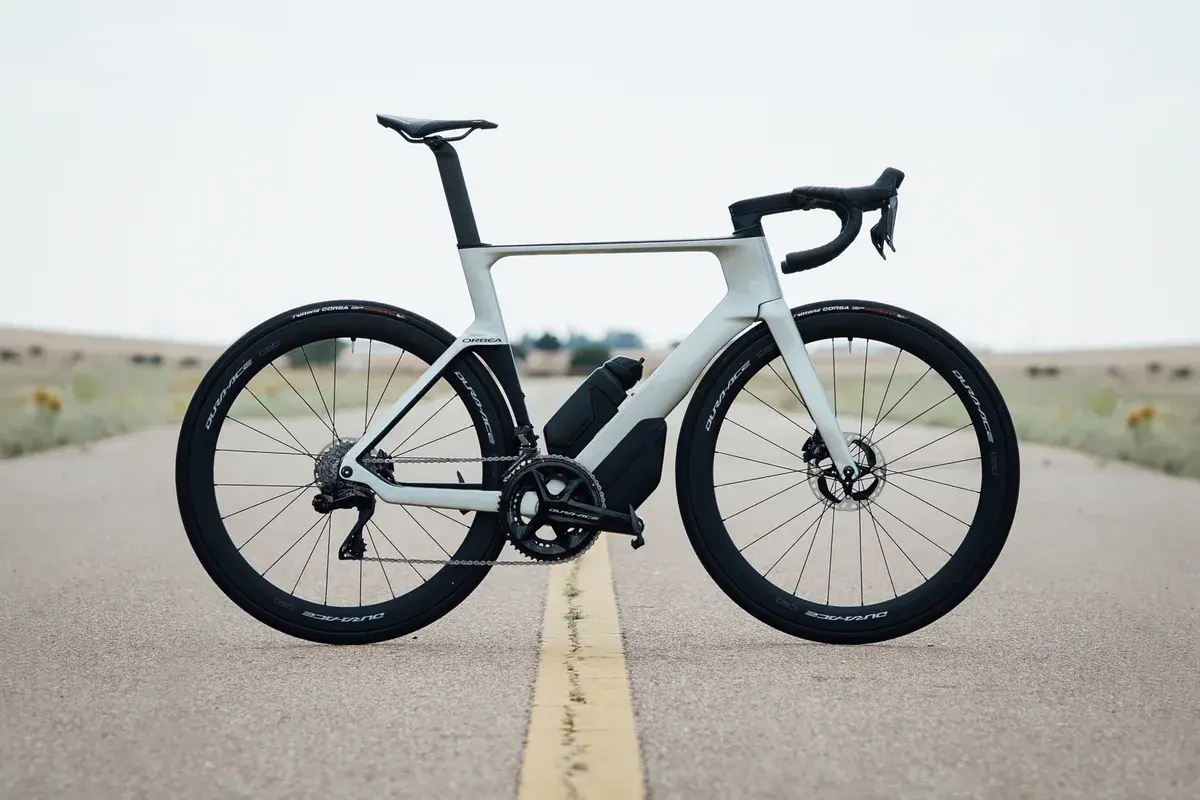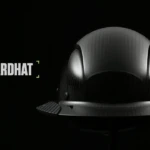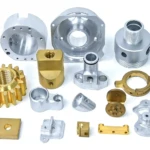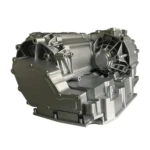In the relentless pursuit of cycling excellence, carbon fiber bike frames have redefined performance standards, blending cutting-edge materials science with precision engineering. Whether you’re an engineer designing the next race-winning frame, a purchasing manager sourcing high-performance components, a startup founder disrupting the market, or a multinational leader scaling production, understanding the technical prowess of carbon fiber bike frames is essential. This article explores how these frames enhance cycling performance through vibration damping, stiffness-to-weight ratios, and aerodynamic tube shaping. We’ll compare manufacturing methods, analyze Tour de France data, and highlight the pivotal role of Prototype CNC Machining Services—with a spotlight on Great Light’s expertise as a leading 5-axis CNC machining factory.
The Current Landscape of Carbon Fiber Bike Frames
The rise of carbon fiber bike frames marks a transformative era in cycling. The global market for carbon fiber composites in bicycles is projected to grow at a CAGR of 7.5% from 2023 to 2030, driven by demand for lightweight, high-performance solutions. Industry giants like Trek, Specialized, and Pinarello lead the charge, while innovative startups leverage customization to carve their niche. Today’s frames aren’t just lighter—they’re smarter, stiffer, and more aerodynamic, thanks to advancements in composite design and manufacturing precision.
Why Carbon Fiber Dominates
- Lightweight Powerhouse: With tensile strengths of 500-700 MPa, carbon fiber rivals steel at a fraction of the weight.
- Tailored Flexibility: Engineers can fine-tune stiffness for sprinters or compliance for long-distance riders.
- Aero Advantage: Moldable into complex shapes, carbon fiber slashes drag, boosting speed.
At Great Light, we marry carbon fiber expertise with 5-axis CNC machining, delivering prototypes and finished parts that push performance boundaries.
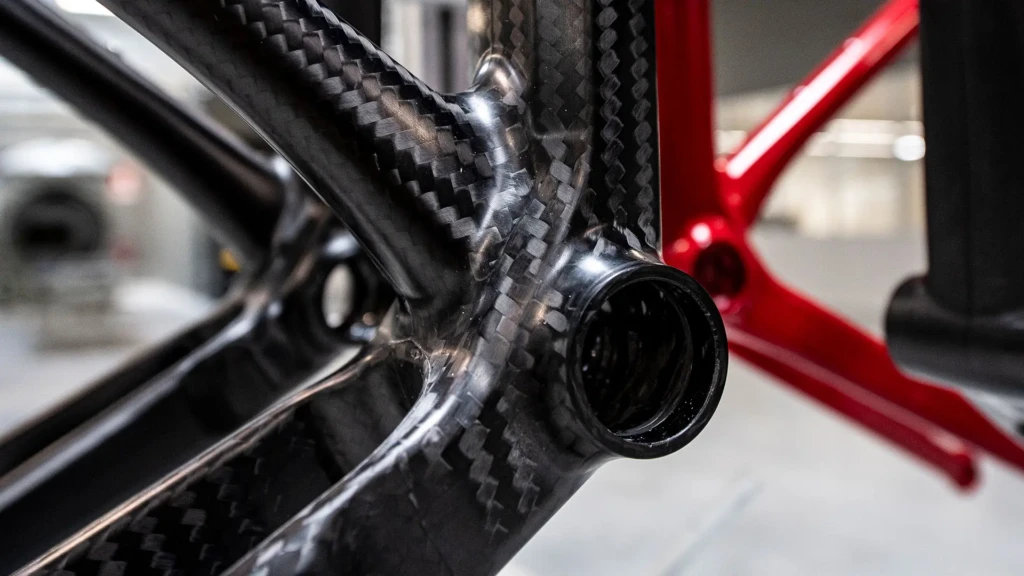
Performance Boosters: A Technical Deep Dive
Let’s unpack the three pillars of carbon fiber bike frame superiority: vibration damping, stiffness-to-weight ratio, and aerodynamic shaping.
Vibration Damping – A Smoother, Faster Ride
Rough roads sap energy and control. Carbon fiber bike frames excel at dampening vibrations, keeping riders fresh and bikes stable.
The Science Behind Damping
- Damping Coefficient: Carbon fiber composites boast a damping coefficient of 0.02-0.05, far surpassing aluminum’s 0.005-0.01. This means vibrations dissipate faster, reducing rider fatigue.
- Quantified Comfort: Research from the University of Colorado shows carbon frames cut high-frequency vibrations by up to 30% compared to aluminum, a game-changer for endurance.
Real-World Racing Edge
- Tour de France Cobblestones: Teams like INEOS Grenadiers rely on carbon’s damping to maintain speed over brutal pavé sections, where every jolt counts.
Stiffness-to-Weight Ratio – Efficiency Unleashed
A frame’s ability to transfer power without excess mass defines its efficiency. Carbon fiber shines here.
Key Metrics
- Specific Stiffness: At 150-200 GPa/g/cm³, carbon fiber trounces aluminum’s 25-30 GPa/g/cm³, delivering rigidity without bulk.
- Featherlight Frames: Elite carbon frames weigh 700-900 grams, while aluminum lags at 1,200-1,500 grams.
Performance Payoff
- Sprint and Climb Gains: Stiffer frames minimize energy loss, propelling riders like Chris Froome to Tour victories on the Pinarello Dogma F12.
- Long-Tail Insight: Search for “carbon fiber bike frame stiffness benefits”? It’s about maximizing every watt.
Aerodynamic Tube Shaping – Speed Through Design
In racing, air resistance is the enemy. Carbon fiber bike frames turn aerodynamics into an ally.
Engineering Aero
- Teardrop Tubes: Carbon’s moldability crafts drag-reducing profiles, cutting resistance by up to 15% over traditional shapes.
- Seamless Integration: Aero seat posts and stems flow with the frame, enhancing efficiency.
Wind Tunnel Proof
- Specialized Venge: Tests reveal a 5-watt savings at 40 km/h, a margin that clinches races.
Manufacturing Methods: Monocoque vs. Lugged
How a carbon fiber bike frame is made shapes its performance and cost. Let’s compare the dominant methods.
Monocoque Construction – Unified Excellence
- How It’s Done: Molded as a single piece, ensuring even stress distribution.
- Pros: Peak stiffness and aerodynamics; scalable for mass production.
- Cons: High mold costs limit small-batch flexibility.
Lugged Construction – Custom Craftsmanship
- How It’s Done: Carbon tubes are bonded into connectors, echoing steel frame traditions.
- Pros: Affordable customization; ideal for prototypes or niche designs.
- Cons: Heavier; joints can be weak points.
Decision Factors
- Engineers: Monocoque for top-tier performance; lugged for bespoke innovation.
- Purchasers: Monocoque rules high-end markets; lugged fits custom orders.
Tour de France: Where Carbon Fiber Proves Itself
The Tour de France is cycling’s ultimate lab. Carbon fiber bike frames consistently deliver.
Team Success and Time Savings
- Jumbo-Visma (2023): Carbon aero frames fueled a record-breaking 42.03 km/h average speed.
- UAE Team Emirates (2022): Tadej Pogačar’s Colnago V3Rs leveraged carbon’s climbing prowess for consecutive wins.
Measurable Impact
- Weight Advantage: A 300-gram lighter frame shaves 30 seconds off a 40 km time trial.
- Aero Edge: Optimized frames save 1-2 minutes over 50 km stages.
Search “carbon fiber bike frame Tour de France performance”? These stats explain the hype.
Prototype CNC Machining Services: The Backbone of Innovation
Behind every carbon fiber bike frame lies precision tooling. At Great Light, our 5-axis CNC machining services elevate frame development.
Crafting Perfect Molds
- Mold Precision: Our 5-axis CNC machines achieve tolerances of ±0.01 mm, critical for monocoque molds.
- Speed to Market: Rapid prototyping cuts design cycles from weeks to days.
Why It Matters
- Performance Link: Flawless molds ensure uniform carbon layups, maximizing strength and aerodynamics.
- Long-Tail Focus: Queries like “CNC machining for carbon bike molds” highlight this unsung hero.
Enhancing Components
- Metal Inserts: CNC-machined titanium or aluminum parts (e.g., bottom brackets) boost durability.
- Finishing Touches: Precision dropouts and engravings add functionality and flair.
Great Light’s Edge
- Versatility: We process metals and composites, offering one-stop solutions.
- Global Reach: From prototype to production, we deliver worldwide.
Trends Shaping the Future
Carbon fiber bike frames are evolving. Here’s what’s next.
Sustainable Composites
- Recycled Fibers: Cutting waste without sacrificing performance.
Smart Frames
- Sensor Integration: Real-time stress monitoring enhances safety.
Personalized Performance
- AI Optimization: Custom layups for every rider’s style.
Great Light: Your CNC Partner
As a premier 5-axis CNC machining factory, Great Light bridges innovation and execution.
- Precision Mastery: Complex geometries? We’ve got it covered.
- Material Expertise: Metals, composites—we handle it all.
- End-to-End Solutions: Prototyping, finishing, and global delivery.
Ready to innovate? Contact us to see how Prototype CNC Machining Services can transform your vision.
Conclusion: Redefining Cycling’s Limits
Carbon fiber bike frames are a triumph of engineering—light, stiff, and aero, they shatter performance barriers. From vibration damping to Tour de France dominance, their impact is undeniable. With Great Light’s 5-axis CNC machining, these frames evolve from concept to reality with unmatched precision. Step into the future of cycling—where every pedal stroke counts.
